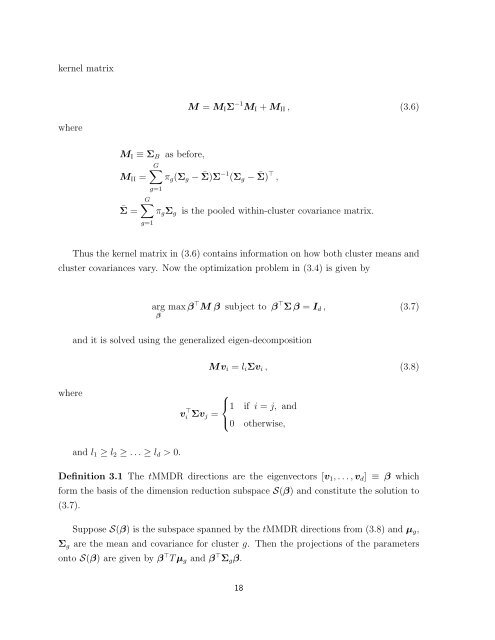Dimension Reduction for Model-based Clustering via Mixtures of ...
Dimension Reduction for Model-based Clustering via Mixtures of ...
Dimension Reduction for Model-based Clustering via Mixtures of ...
You also want an ePaper? Increase the reach of your titles
YUMPU automatically turns print PDFs into web optimized ePapers that Google loves.
kernel matrixM = M I Σ −1 M I + M II , (3.6)whereM I ≡ Σ B as be<strong>for</strong>e,G∑M II = π g (Σ g − ¯Σ)Σ −1 (Σ g − ¯Σ) ⊤ ,g=1G∑¯Σ = π g Σ gg=1is the pooled within-cluster covariance matrix.Thus the kernel matrix in (3.6) contains in<strong>for</strong>mation on how both cluster means andcluster covariances vary. Now the optimization problem in (3.4) is given byargβmax β ⊤ M β subject to β ⊤ Σ β = I d , (3.7)and it is solved using the generalized eigen-decompositionMv i = l i Σv i , (3.8)where⎧⎨1 if i = j, andvi ⊤ Σv j =⎩0 otherwise,and l 1 ≥ l 2 ≥ . . . ≥ l d > 0.Definition 3.1 The tMMDR directions are the eigenvectors [v 1 , . . . , v d ] ≡ β which<strong>for</strong>m the basis <strong>of</strong> the dimension reduction subspace S(β) and constitute the solution to(3.7).Suppose S(β) is the subspace spanned by the tMMDR directions from (3.8) and µ g ,Σ g are the mean and covariance <strong>for</strong> cluster g. Then the projections <strong>of</strong> the parametersonto S(β) are given by β ⊤ T µ g and β ⊤ Σ g β.18
















